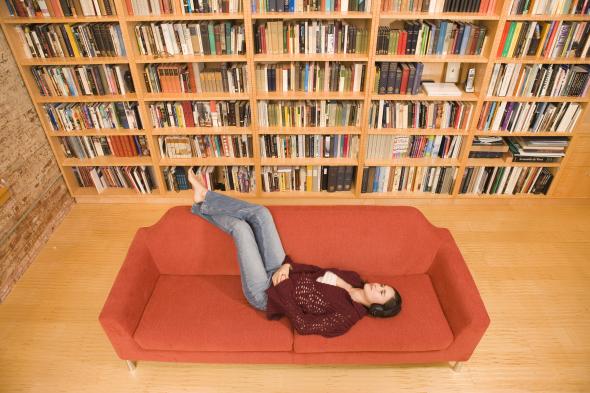Having an Aspirational Home Library Is Totally Normal

Ingram Publishing/Thinkstock
The Pew Research Center reported last month that more than a quarter of Americans have not read a book in the last year, a proportion that has more than tripled since the late 1970s. But take heart! Books seem to be cooler than ever these days. In the Year of our Lord 2016, you can buy perfume and candles, duvet covers and sweatshirts to advertise that you love them. One can be “obsessed” with books now without being much of a reader. Recall, if you will, this instantly iconic recent exchange between Kris and Khloe Kardashian:
Kris: “I’m obsessed with books right now. I’m reading a book about Le Courvoisier [sic], which is an architect. It’s so weird and boring, but I’m obsessed.”
Khloe: “No you’re not. And you’re not reading that book.”
Kris: “Well, I look at them.”
Khloe: “Right, you look at it. It’s not a real book.”
Kris: “It has words.”
Khloe: “Oh, ‘This building was erected in nineteen-whatever’?”
Kris: “Yes, it’s called history.”
Khloe: “That’s a coffee table book.”
As I have done so many times before, I must ask: Is Khloe Kardashian right? Is there something just a little bit gauche about displaying books in one’s home that one isn’t actually reading, and has no intention of reading? I have no intention of consuming The Brontës at Haworth or The Woman’s Day Book of American Needlework cover to cover, but nor are they fraudulent representations of my interests. Is it acceptable to treat books as decor, a representation of one’s aesthetic aspirations rather than one’s intellectual biography? What is the normal approach to displaying books in one’s home?
An informal survey of 50 friends and Slate colleagues suggests, disappointingly for the cause of grand pronouncements, that everyone is different and moderation is key. About 22 percent of survey-takers think it’s tacky to display books one has no intention of reading; the plurality said it was normal to do so only in small doses. Almost 70 percent said they’d read at least 40 percent of the books in their home. (Pretty impressive considering that my sample was skewed heavily toward people who receive free books as part of their jobs.) A slim majority said they at least intended to pick up at least 40 percent of their unread volumes. As for systems management, more than half of respondents said they don’t organize their books at all.
In my own home, I strive for moderation. I’m semi-organized, with separate bookcases for fiction and non-fiction; non-fiction is further grouped loosely by subject matter. On a few shelves, I’ve stacked coffee-table books horizontally with knick-knacks on top, a trick I picked up working at a home-decor magazine. I aim for a loose kind of honesty in what I keep around, too: I long ago banished my college copies of Kant and Hegel. But I do keep cooler, smarter books at eye-level, and I shunt the trashy and random up toward the ceiling. I’d rather visitors ask me about The Lives of Margaret Fuller than The Pace Picante Sauce 40th Anniversary Recipe Collection.
But I try to resist tilting too far in the direction of Ron Burgundy and his “many leather-bound books.” Buying “Books by the Foot” seems almost barbarian for anyone other than set decorators. (“Shelf-ready books that will display attractively,” starting at just $6.99 a foot.) I even cringe at those ubiquitous Instagram shots of teetering “TBR piles,” often accompanied by humble-brag captions about how overwhelmed the reader is. It’s one thing to brag about what you’ve read, but bragging about what one intends to read is a bit much. (My TBR pile is the entire Western canon. Ack, how will I ever finish?)
Some survey-takers took this squeamishness so far that they were incredulous at the very concept of “displaying” books. “Do people really keep books to display them?” one colleague asked. “A private library is a promise to yourself, not a premise about your personhood.” But I say that’s purist nonsense. Books have always played both roles. They are not just stories and information, they are badges of identity and, yes, ornamentation. A book on a shelf faces inward and outward at the same time.
Read more from Normal, Slate's pop-up blog about how you're supposed to do it.
